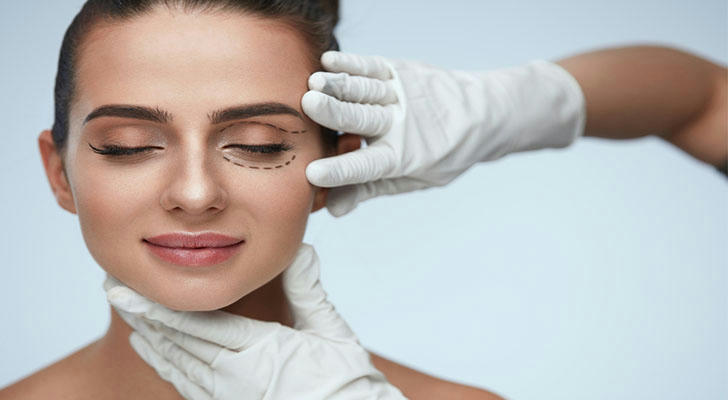Am I a good candidate for blepharoplasty? How do I know if I need surgery?

Blepharoplasty is a cosmetic procedure that surgically removes or adjusts excess skin and fat from the upper or lower eyelids. It not only improves eye bags and sagging eyelids caused by aging or genetics, but also improves vision and eye function. After surgery, the eye contour is more defined and the overall appearance appears younger and more energetic.
Types of blepharoplasty
1.Upper blepharoplasty
• For the upper eyelid, it improves eyelid drooping by removing excess skin and fat, improving vision and appearance.
2.Lower blepharoplasty
• For the lower eyelid, it removes or adjusts eye bags and fat to restore the smoothness and firmness of the lower eyelid.
3.Double eyelid surgery
• Mainly used in Asian populations, it creates a natural double eyelid effect by forming a fold in the upper eyelid.
4.Composite blepharoplasty
• Surgery on the upper and lower eyelids is performed at the same time to comprehensively solve the aesthetic problems of the upper and lower eyelids.
Main purpose
1.Improve appearance
• Remove or adjust excess skin and fat on the eyelids to rejuvenate and eliminate the appearance of fatigue and aging.
2.Improve eye function
• Improve the problem of limited vision caused by drooping eyelids and improve the quality of daily life.
3.Enhance self-confidence
• Improve the beauty of the eyes, make the overall appearance more harmonious, and help restore or enhance self-confidence.
Suitable people who need surgery
1.People with loose eyelids
• Loose skin on the upper or lower eyelids, affecting vision and appearance.
2.People with eye bags or fat accumulation
• Protruding eye bags or fat accumulation on the lower eyelids.
3.People with aging eye appearance
• Drooping eyelids, loose skin, and increased wrinkles.
4.People who need double eyelids
• Born with single eyelids or asymmetrical double eyelids.
5.People whose vision is affected by eyelid problems
• Loose skin on the upper eyelids blocks vision.
6.People who want to improve their self-image
• People who want to improve their overall appearance.
7.People in good health
• Generally in good health, without serious chronic diseases or eye infections.
How to determine whether you are suitable for surgery
1.Health assessment
• Confirm that there are no health problems that affect surgery and conduct a routine physical examination.
2.Eye problem examination
• Assess skin looseness and fat accumulation.
3.Expectation and needs analysis
• Confirm the expectations and actual needs for the surgical results.
4.Psychological state assessment
• Ensure that you have reasonable expectations for the results of the surgery and be mentally prepared.
5.Professional doctor consultation
• Consult in detail to discuss the indications for surgery, expected results and risks.
6.Lifestyle and habits
• Understand whether you can follow the postoperative care recommendations and recovery plan.
7.Alternatives consideration
• Consider whether non-surgical treatment methods are more suitable for your needs.
Real case sharing
1.Case 1: Ms. Li (55 years old)
• Background: Ms. Li had drooping eyelids and prominent eye bags, which made her look tired and affected her vision.
• Surgery: She chose upper and lower blepharoplasty to remove excess skin and fat.
• Results: After the operation, Ms. Li's vision improved significantly, her face looked younger and more energetic, and her self-confidence was greatly improved.
2.Case 2: Mr. Zhang (42 years old)
• Background: Mr. Zhang had obvious eye bags and upper eyelid sagging, which affected his appearance and daily life.
• Surgery: He underwent lower eyelid blepharoplasty to remove eye bags and adjust the fat of the lower eyelid.
• Results: After the surgery, his eye contour became tighter, improving appearance and function, and also improving his self-confidence.
3.Case 3: Ms. Wang (28 years old)
• Background: Ms. Wang hoped to improve her monolid problem through double eyelid folds and make her eyes look bigger.
• Surgery: She chose double eyelid folds to form natural double eyelid folds.
• Results: After the surgery, Ms. Wang's eyes looked more energetic and her overall appearance improved significantly. She was very satisfied with the results of the surgery.
Conclusion
To determine whether you need blepharoplasty, first evaluate whether you have obvious eye problems, such as sagging eyelids, prominent eye bags, or limited vision. Second, consider whether you want to improve your appearance or function, and whether you have reasonable expectations for the results of the surgery. If you decide to have surgery, you need to choose an experienced doctor and fully understand the risks, costs, and postoperative care requirements of the surgery. Make informed decisions based on your health status, needs, and expectations to ensure the best outcome from your surgery.
